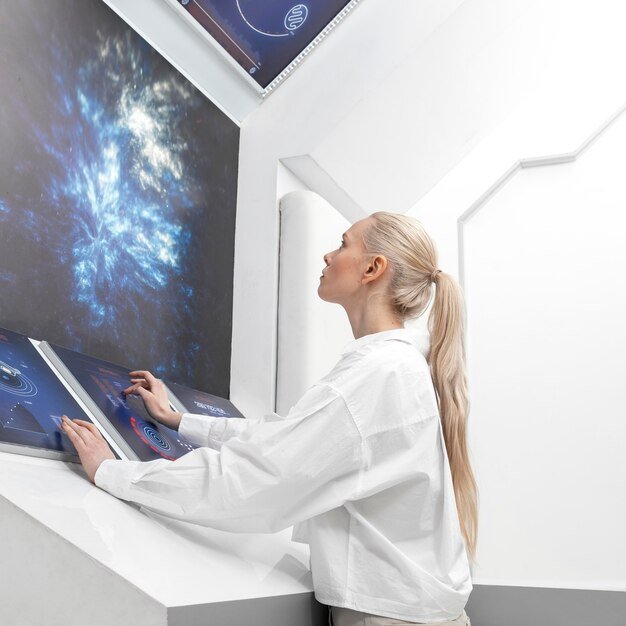Introduction
In the rapidly evolving field of healthcare, AI-powered medical imaging is revolutionizing diagnostic accuracy and efficiency. By leveraging artificial intelligence (AI), machine learning (ML), and deep learning (DL), medical imaging technologies can detect diseases at early stages, enhance radiological interpretations, and improve patient outcomes. This article explores the role of AI in medical imaging, its benefits, applications, challenges, and future potential.
The Role of AI in Medical Imaging
What is AI-Powered Medical Imaging?
AI-powered medical imaging refers to the use of artificial intelligence algorithms to process, analyze, and interpret medical images such as X-rays, CT scans, MRIs, and ultrasounds. These AI-driven solutions help healthcare professionals detect abnormalities, diagnose diseases, and make data-driven clinical decisions.
How AI Enhances Medical Imaging?
- Automated Image Analysis – AI can analyze complex images faster and with higher accuracy than traditional methods.
- Early Disease Detection – AI helps identify diseases like cancer, stroke, and cardiovascular conditions in early stages.
- Improved Workflow Efficiency – AI minimizes human workload, reducing diagnostic errors and processing times.
- Advanced 3D Imaging – AI enhances 3D visualization, aiding in surgical planning and precision medicine.
Key Benefits of AI in Medical Imaging
1. Increased Accuracy and Precision
- AI-driven algorithms reduce misdiagnoses by detecting subtle anomalies in medical images.
- Deep learning models outperform traditional radiological methods in detecting diseases.
2. Faster Diagnosis and Treatment
- AI accelerates image analysis, providing real-time insights.
- Speedy diagnostics lead to early interventions, improving patient outcomes.
3. Cost-Effective and Scalable Solutions
- AI minimizes unnecessary imaging scans, reducing healthcare costs.
- Automated systems handle large datasets, making medical imaging scalable.
4. Enhanced Radiology Workflow
- AI assists radiologists by prioritizing critical cases.
- Reduces manual workload, allowing physicians to focus on complex cases.
5. AI-Enabled Predictive Analytics
- AI predicts disease progression based on historical imaging data.
- Helps in personalized treatment planning.
Applications of AI in Medical Imaging
1. AI in Radiology
- AI aids in detecting tumors, fractures, infections, and other abnormalities in X-rays and MRIs.
- Automated AI systems flag critical cases for immediate review.
2. AI in Oncology Imaging
- AI enhances early cancer detection in mammograms, lung CT scans, and colonoscopies.
- AI-powered biopsy analysis improves precision in cancer staging.
3. AI in Neurology Imaging
- AI detects Alzheimer’s disease, strokes, and multiple sclerosis in brain scans.
- Assists in differentiating between neurological disorders with high accuracy.
4. AI in Cardiology Imaging
- AI-powered echocardiograms detect heart diseases, arrhythmias, and cardiac arrest risks.
- Helps cardiologists assess heart health and recommend treatments.
5. AI in Ophthalmology Imaging
- AI-based retinal imaging identifies diabetic retinopathy, glaucoma, and macular degeneration.
- Enhances early diagnosis, preventing vision loss.
Challenges in AI-Powered Medical Imaging
1. Data Privacy and Security Concerns
- AI systems require access to large medical datasets, raising patient data privacy issues.
- Compliance with regulations like HIPAA and GDPR is essential.
2. Integration with Existing Systems
- Many healthcare facilities use legacy systems that may not support AI integration.
- Requires cloud-based solutions and interoperability standards.
3. Ethical and Legal Challenges
- AI-driven diagnoses raise concerns about accountability in medical decision-making.
- Clear guidelines on AI liability are needed to address potential errors.
4. Need for Extensive Training Data
- AI models require vast, diverse, and high-quality datasets to improve accuracy.
- Data biases in AI training can lead to incorrect diagnoses.
5. Physician Acceptance and Trust
- Some medical professionals remain skeptical about AI’s reliability.
- AI should be viewed as an assistive tool rather than a replacement for radiologists.
Future of AI in Medical Imaging
1. AI-Driven Personalized Medicine
- AI enables customized treatments based on individual imaging profiles.
- Enhances precision medicine for cancer and chronic diseases.
2. Integration of AI with Robotics
- AI-powered robotic surgery assists in minimally invasive procedures.
- Provides real-time imaging guidance during operations.
3. Expansion of AI in Remote Diagnostics
- AI telemedicine platforms allow remote diagnosis for underserved areas.
- Helps in global healthcare accessibility.
4. AI-Powered Drug Development
- AI imaging aids in biomarker discovery and pharmaceutical research.
- Accelerates new drug development and trials.
5. Advanced AI-Generated 3D Imaging
- Future AI models will enhance 3D imaging reconstruction for complex diseases.
- Will aid in better surgical planning and diagnostics.
FAQs (Frequently Asked Questions)
Q1: Can AI replace radiologists in the future?
No, AI is designed to assist rather than replace radiologists. AI enhances efficiency and accuracy but still requires human oversight for complex cases.
Q2: Is AI in medical imaging safe for patient diagnosis?
Yes, AI undergoes rigorous testing and validation to ensure safety and reliability. However, it should be used as a supportive tool alongside medical expertise.
Q3: How does AI improve cancer detection in imaging?
AI analyzes imaging patterns to identify tumors at early stages, increasing the accuracy of cancer detection and reducing false positives/negatives.
Q4: What are the challenges of implementing AI in hospitals?
Key challenges include data privacy concerns, integration with existing systems, high costs, and physician acceptance.
Q5: How can AI benefit rural healthcare facilities?
AI enables remote diagnostics, telemedicine imaging analysis, and automated detection, making healthcare accessible in underserved regions.
Conclusion
AI-powered medical imaging is transforming diagnostic accuracy, efficiency, and patient care. By leveraging machine learning, deep learning, and automation, AI enhances radiology, oncology, neurology, and cardiology imaging. Despite challenges in data security, system integration, and ethical concerns, AI continues to revolutionize the healthcare industry. As technology advances, AI-driven medical imaging will play an increasingly vital role in early disease detection, personalized treatment, and global healthcare accessibility.
The future of AI in medical imaging looks promising, with advancements in 3D imaging, robotics, and precision medicine. By integrating AI solutions into healthcare workflows, we can improve patient outcomes, reduce diagnostic errors, and enhance the efficiency of medical imaging worldwide.





